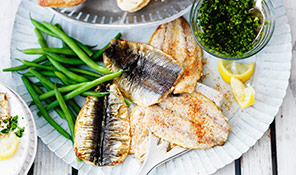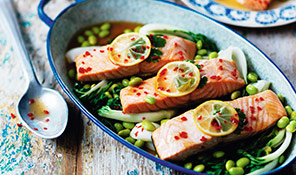
10 ways to a healthier you
Not just for Fridays, fish is a great source of nutrients like B vitamins and minerals, which are important for a healthy, balanced diet.
Oily fish is one of the few dietary sources of bone-boosting vitamin D, and scaling up how much you eat might also be a good idea for both the grey matter and vision, as one of the types of omega-3 fats in oily fish (DHA) helps with normal brain and eye function.
If you’re watching your weight you’ll be happy to know that all fish – including white, oil-rich and shellfish – is a good source of protein, which helps to keep you fuller for longer, so you're less likely to snack between meals! White fish and shellfish also tends to be low in fat.
We should aim for at least 2 portions of fish a week, 1 of which is oily. A portion is 140g (cooked), which is roughly equivalent to a medium-sized white fish such as cod or haddock, a medium-sized oily fish such as mackerel or a tin of drained tuna or salmon.
Oily fish
Herring
Sardines
Pilchards
Salmon
Trout
Snapper
Tilapia
Kippers
Mackerel
White fish
Sea bass
Sea bream
Cod
Haddock
Hale
Coley
Whiting
Mullet
Halibut
Lemon sole
Plaice
Shellfish
Mussels
Prawn
Scallop
Crab
Crayfish
Squid
Lobster
Oyster
Cockles
Clams
Langoustine

Nicola’s top tips
Our Nutritionist Nicola Selwood, shares her top tips on how to introduce more fish into your diet.













You don't have to be a confident cook
Fish doesn’t have to be fiddly to prepare, or expensive. Frozen fish is often cheaper and just as nutritious as fresh, and canned oily fish such as mackerel and salmon is a convenient way to get omega-3. An exception is canned tuna, which doesn’t contain omega-3 while fresh tuna does.
You can eat shellfish
It’s a misconception that you need to avoid prawns (or other shellfish) due to their higher cholesterol content. Prawns do contain more cholesterol than many other fish, but research shows that, for most people, the cholesterol in foods like prawns has little effect on blood cholesterol levels. Instead, it’s more important to cut down on saturated fat, something shellfish are naturally low in.
Get the kids hooked
If your children only eat fish fingers, don’t worry, they can be a good way to introduce children to eating fish. If you want to increase their omega-3 intake you can even find varieties where the breadcrumbs have been fortified with it, like Birds Eye Fish Fingers With Omega 3. Try choosing products that contain 100% fish such as essential Waitrose 6 Cod Fillet Fingers In Breadcrumbs.




Be inspired with our healthy eating ideas...













